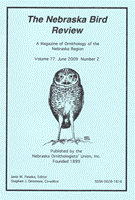Nebraska Ornithologists' Union

Nebraska Bird Review
Date of this Version
12-1986
Document Type
Article
Citation
Barbara L. Wilson, “Writing a Documentation,” from Nebraska Bird Review (December 1986) 54(4).
Abstract
As the previous article makes clear, the written documentation helps birdwatchers communicate clearly about unusual sightings. Preparing the report can even add to the excitement of the event as one settles into a comfortable chair with the field notes and paper, chortling “Wait ‘til they read about this!” Then one relives the whole experience while organizing one’s thoughts for writing. Those field notes are an important part of the process, for they keep small but critical details accurate. Train yourself to take some kind of notebook or paper into the field, though in a pinch the margin of a field guide or the back of a shopping list will do. Write notes while looking at a bird or as soon afterward as possible. Since you will make notes as the bird’s characteristics become apparent to you, your field notes will be disorganized and repetitive, not to mention illegible. That’s fine; no one but you need ever see them.
Take notes as soon as possible and preferably before consulting a field guide or while consulting a guide and also watching the bird. Memory is profoundly modified by expectations (see the extensive literature on problems with eyewitness testimony in criminal trials), so it is important to get your impressions down on paper quickly, before tricky memory rewrites the whole thing.


Comments
Copyright 1986 Nebraska Ornithologists’ Union. Used by permission.